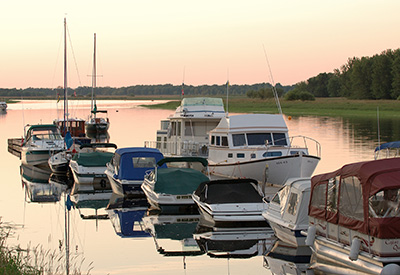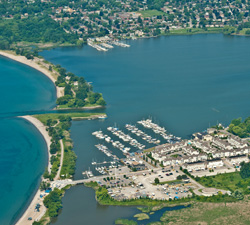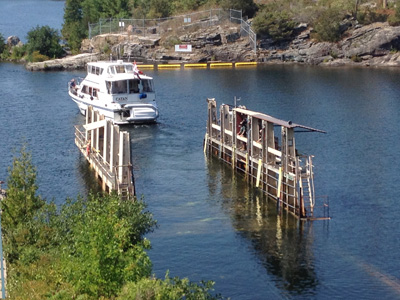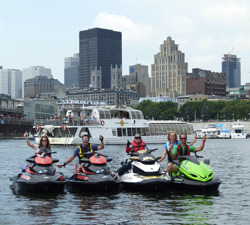Planning Your Dream Cruise: 6 – Maintaining A Home Base While Cruising

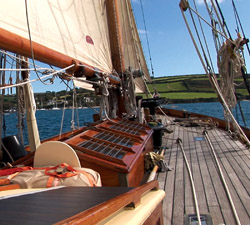 In previous editions of CY, we have talked about preparations for cruising, choosing destinations, potential costs, managing money from afar, earning money while cruising, and the benefits of part-time cruising. In this, Part 6, we discuss the pros and cons of maintaining a home base while cruising, choosing a secure place to store your boat in a foreign port when you’re away and possible customs issues that might arise from storing your boat overseas.
In previous editions of CY, we have talked about preparations for cruising, choosing destinations, potential costs, managing money from afar, earning money while cruising, and the benefits of part-time cruising. In this, Part 6, we discuss the pros and cons of maintaining a home base while cruising, choosing a secure place to store your boat in a foreign port when you’re away and possible customs issues that might arise from storing your boat overseas.
Pros and Cons of Maintaining a Home Base while Cruising
The decision to cast off the dock lines and undertake a long-term cruise involves considerate financial planning from establishing a budget for outfitting your boat, travelling expenses, insurance, sightseeing costs, maintenance and repairs, and changing costs of living as you move from destination to destination. So it’s no surprise that in the process of planning a cruise, the topic of whether or not it’s economical to maintain a home base while you’re away nearly always comes up.
Keeping your home or an alternative home base to return to gives you a safety net that provides a great sense of security when you’re “out there” cruising but can be expensive to maintain when you’re managing the cost of your cruise as well. However, giving up the family home is often a major block preventing one or both partners from fulfilling their dream of going cruising so if this is the case we say don’t give it up. During 18 years and 50,000 nautical miles of international cruising, Paul and I have learned first-hand, as well as from the experiences of cruising friends, that there are many ways to maintain an home base affordably, and often profitably, while cruising.
We, like many of our long-term cruising friends, started out by “selling up to sail”. We didn’t want the hassles or worries of trying to rent out our place. We just wanted to sail and be carefree. And at the time we needed the money to make the cruise a reality. Besides, whenever we went home for a visit we had lots of family to stay with who were happy to have us for long periods of time. These visits were always a delight but despite this, after several years of living afloat, we started to feel rootless and longed to have our own base again where our paintings were hanging on the wall, our good china was on the table and I could enjoy once again all the domestic treasures that had been packed in storage since the day we first sail, at least for a few months of the year.
Paul and I are marine authors and filmmakers (our sailing TV series airs weekly on Canadian Learning Television) so are in the fortunate position to be able to earn a living while we’re cruising. So when we realized we were at a point in our careers and cruising lives where we needed a break from the boat from time to time and to have a base ashore that we could come home to, we could still afford to get in to the market. We chose a condo townhouse so we could benefit from ownership and increasing property values but not have to worry about lawn maintenance etc. when we’re sailing which is handled by the condo association.
Not everyone living on a boat needs a fix of shore life like we do. Many cruisers make the decision to keep a home base purely for economic reasons. If you own a home and then sell it but don’t get back into the market until years later it can be financially difficult to do. As a general rule, real estate increases in value over the long term so even if you have no desire to use your home as a base, holding on to it by renting it out not only provides you with rental income but it means you can hang on to the property and benefit from its increase in value over the years. Then if you do decide later to move back ashore or make a change in your cruising lifestyle, you have a financial nest egg.
The two most important things for making rental income work out for you are to be very sure you have good tenant – not always an easy thing to determine – and someone reliable to manage the property for you (i.e. handle repairs and maintenance, negotiate possible disputes, collect rental payments, etc.).Problems with tenants can really ruin a cruise. When cruising, communication is not always easy so you don’t want to try and handle things from afar. If you are out of sight you are often out of mind, which can create problems.
Long-term rentals are generally the most successful and easy to manage. When our friends, Gord and Sue aboard Lady Simcoe, decided to take a two-year sabbatical and go cruising they rented out their home for that period which proved to be a very positive experience. They carefully interviewed prospective tenants and not only did they find wonderful people, the rent money covered all the costs of keeping the home they enjoy and wanted to come back to and provided some additional income to help with their cruising costs. They had a good relationship with the tenants who loved their place that gave them an added sense of security and as Sue says, “Our place was in better shape when we returned than when we left! Our tenants really took care of our home and did a lot of maintenance and improvements. If you get the right tenants we’d definitely recommend this as the route to go.”
When our friends, Pete and Trisha aboard Jenny Wren, decided to go cruising full-time after getting their kids through school and happily settled, they made the decision to sell their large family home and downsize to a comfortable waterfront condo apartment in a resort community where there is a demand for weekly rentals to tourists in the summertime. A reliable property management company handles this so in the summer months Pete and Trisha spend their time aboard their lovely 38-foot classic pilot cutter sailing worry-free and earning income from their rental properties. In the wintertime, when life aboard isn’t so pleasant and the condo is difficult to rent out, they move in themselves for a cosy break ashore.
If you still want to keep your own home yet the whole rental thing is intimidating, an alternative is to have a member of the family or close friend move in to house-sit when you’re away. This is more costly since the usual agreement is that the owners carry the costs of the house, except perhaps for utilities if agreed, but although it doesn’t provide income it does provide security and the benefit of owning property that is most likely increasing in value.
We have cruising friends whose home is in a university town. They have a niece who is a student at the university so she lives in the house for most of the year when she is attending school and looks after the house while Rob and Mary are down south cruising during the cold months of school term. Then when the niece heads home in the summertime they move back into the house for the best months of the year. If they change their plans and want to come home for a Christmas visit or for a medical check-up, their home is still open to them. With regular tenants this wouldn’t be possible.
There are definitely pros and cons to maintaining a home base while you’re cruising but if it’s important to your sense of security, whether emotional or economic or both, there are various ways and means to achieve this.
Leaving Your Boat
If you’ve made the decision to come home for part of the year when living aboard, the question now arises about where and how to leave your boat during your time ashore. If you are on a long-distance voyage it doesn’t make sense to bring the boat home every visit. It takes too much time and puts wear and tear on the boat. Paul and I realized early on that we could see more places if we sailed for a season, then hauled the boat out in a secure marina wherever we ended up, came home to complete our work projects for a few months, then flew back and sailed onwards for a new season in new and more distant cruising grounds.
There are many popular and safe places around the world where cruising sailors plan to leave their boats for a few months while they travel ashore or go home for a visit. It only takes a little bit of research on the internet through cruising forums, cruiser web sites, or by reading cruising guides or bulletins of cruising associations such as the Seven Seas Cruising Association to learn where these places are.
While cruising in the Mediterranean for the last few years we have “wintered” our boat at Marina Bay in Gibraltar, Almerimar on the south coast of Spain, Msida Marina in Malta, Leros Marina in Leros, Greece, and Ece Saray Marina and Yacht Marine in Turkey. Many northern Europeans leave their boats in these marinas for the winter so the marinas are set up to store boats long-term both in and out of the water. For example at Yacht Marine in Marmaris, Turkey, you can pay to have a web cam positioned overlooking your boat so you can check on it when you’re home!
Assuring Your Boat’s Security
Marinas such as the ones mentioned above take pride in their reputations for offering secure boat storage facilities and recommendations are always available throughout the cruising community. Services we look for are 24-hour security guards, enclosed boat yards with locking gates and lots of lights. We check out the way the boats are hauled out and blocked to be sure the jobs are done safely and properly. We make sure it is easy to communicate with the marina staff so that we can be comfortable about calling frequently for reports on the boat while we’re away. In areas of high humidity we arrange to have someone come on the boat and check for mildew, deal with desiccants, etc. Another feature we look for when determining where to leave our boat for a while is that there are lots of live-aboards in the marina. Sailors always look out for each other’s boats so even if the marina has a good reputation it is comforting to know that other sailors are keeping an eye on the boat too.
Customs Issues if Storing your Boat Overseas
Before deciding to leave your boat in a foreign country, check on any customs requirements for doing this. Good resources are the embassy of the country, cruising associations and guidebooks, as well as the marina office of your choice are good resources. Often cruising permits for your boat have a limited time and if this runs out while you are at home, you may need to place your boat “in bond” to stop the clock or arrange an extension before you fly home.
A balance of life afloat and life ashore works well for many long-term cruisers and makes financial sense in many cases. No matter if you’re plans are for a two-month cruise, a two-year cruise, or planned for a lifetime; everyone’s cruising lifestyle is unique. The freedom to choose, to come and go as delights you is what counts; there are a multitude of opportunities and alternatives to find the right recipe for happiness.
Paul and Sheryl Shard are the authors of the bestselling book, “Sail Away! A Guide to Outfitting and Provisioning for Cruising” and the hosts of the award-winning sailing TV series, “Distant Shores” which is also available on DVD. They have just sold their Classic 37 sailboat, Two-Step, their cruising home for nearly 20 years, and will be continuing their adventures aboard their new Southerly 42. Follow their upcoming transatlantic voyage on www.distantshores.ca

